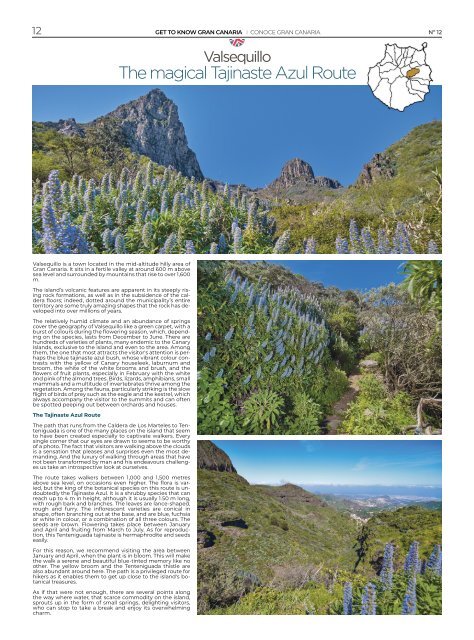No. 12 - Its Gran Canaria Magazine
Rutas, recomendaciones y noticias de Gran Canaria Routes, tips and news about Gran Canaria
Rutas, recomendaciones y noticias de Gran Canaria
Routes, tips and news about Gran Canaria
You also want an ePaper? Increase the reach of your titles
YUMPU automatically turns print PDFs into web optimized ePapers that Google loves.
<strong>12</strong><br />
GET TO KNOW GRAN CANARIA I CONOCE GRAN CANARIA Nº <strong>12</strong><br />
Valsequillo<br />
The magical Tajinaste Azul Route<br />
Valsequillo is a town located in the mid-altitude hilly area of<br />
<strong>Gran</strong> <strong>Canaria</strong>. It sits in a fertile valley at around 600 m above<br />
sea level and surrounded by mountains that rise to over 1,600<br />
m.<br />
The island’s volcanic features are apparent in its steeply rising<br />
rock formations, as well as in the subsidence of the caldera<br />
floors; indeed, dotted around the municipality’s entire<br />
territory are some truly amazing shapes that the rock has developed<br />
into over millions of years.<br />
The relatively humid climate and an abundance of springs<br />
cover the geography of Valsequillo like a green carpet, with a<br />
burst of colours during the flowering season, which, depending<br />
on the species, lasts from December to June. There are<br />
hundreds of varieties of plants, many endemic to the Canary<br />
Islands, exclusive to the island and even to the area. Among<br />
them, the one that most attracts the visitor's attention is perhaps<br />
the blue tajinaste azul bush, whose vibrant colour contrasts<br />
with the yellow of Canary houseleek, laburnum and<br />
broom, the white of the white brooms and brush, and the<br />
flowers of fruit plants, especially in February with the white<br />
and pink of the almond trees. Birds, lizards, amphibians, small<br />
mammals and a multitude of invertebrates thrive among the<br />
vegetation. Among the fauna, particularly striking is the slow<br />
flight of birds of prey such as the eagle and the kestrel, which<br />
always accompany the visitor to the summits and can often<br />
be spotted peeping out between orchards and houses.<br />
The Tajinaste Azul Route<br />
The path that runs from the Caldera de Los Marteles to Tenteniguada<br />
is one of the many places on the island that seem<br />
to have been created especially to captivate walkers. Every<br />
single corner that our eyes are drawn to seems to be worthy<br />
of a photo. The fact that visitors are walking above the clouds<br />
is a sensation that pleases and surprises even the most demanding.<br />
And the luxury of walking through areas that have<br />
not been transformed by man and his endeavours challenges<br />
us take an introspective look at ourselves.<br />
The route takes walkers between 1,000 and 1,500 metres<br />
above sea level, on occasions even higher. The flora is varied,<br />
but the king of the botanical species on this route is undoubtedly<br />
the Tajinaste Azul. It is a shrubby species that can<br />
reach up to 4 m in height, although it is usually 1.50 m long,<br />
with rough bark and branches. The leaves are lance-shaped,<br />
rough and furry. The inflorescent varieties are conical in<br />
shape, often branching out at the base, and are blue, fuchsia<br />
or white in colour, or a combination of all three colours. The<br />
seeds are brown. Flowering takes place between January<br />
and April and fruiting from March to July. As for reproduction,<br />
this Tenteniguada tajinaste is hermaphrodite and seeds<br />
easily.<br />
For this reason, we recommend visiting the area between<br />
January and April, when the plant is in bloom. This will make<br />
the walk a serene and beautiful blue-tinted memory like no<br />
other. The yellow broom and the Tenteniguada thistle are<br />
also abundant around here. The path is a privileged route for<br />
hikers as it enables them to get up close to the island's botanical<br />
treasures.<br />
As if that were not enough, there are several points along<br />
the way where water, that scarce commodity on the island,<br />
sprouts up in the form of small springs, delighting visitors,<br />
who can stop to take a break and enjoy its overwhelming<br />
charm.

















